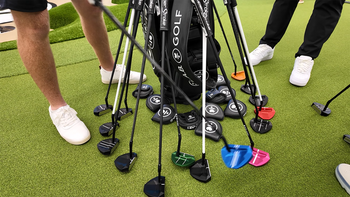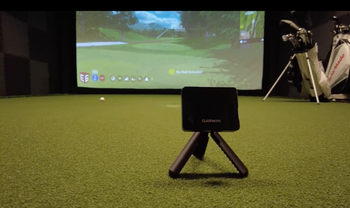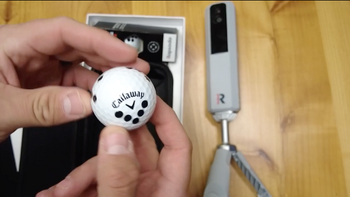My guess is that you’ve heard plenty of reasons why you should buy the Garmin R10 Launch Monitor.
And I’ll admit, a lot of those reasons are legit.
The Garmin R10 is a very solid launch monitor. I mean, it’s a Garmin. And for less than $600, the R10 offers accurate data tracking, built-in simulation capabilities, and third-party integration, which alone might make it a good value. It’s an awesome launch monitor, no question.
But I gotta say, for a lot of golfers, I don’t think the Garmin R10 is the right fit. I think many of you would be better off with a different launch monitor.
So in today’s video, I’m going to share with you the five big reasons why I think you want to not buy the Garmin R10. While the Garmin R10 may seem appealing at first glance, there are various factors that could outweigh its advantages. Before making a purchase, it’s essential to consider not only the potential drawbacks but also the Garmin R10 benefits for golfers, which include enhanced data analysis and swing insights. Ultimately, it’s crucial to weigh these benefits against your specific needs and preferences in order to make an informed decision.
So, let’s do it
Garmin Approach R10 Launch Monitor
Garmin Approach R10 brings powerful launch monitoring to your game with unmatched portability.
Table of Contents
Reason Number One: Accuracy Limitations, Especially Indoors
The R10 only directly measures four things: ball speed, club speed, launch angle, and launch direction. Everything else — spin, curvature, deviation, apex, face-to-path, attack angle — is generated by an algorithm.
That doesn’t mean the numbers are worthless. In fact, outdoors, distance and speed numbers with the R10 are very solid. But when you step indoors, the story changes. Unless you’re hitting Titleist RCT golf balls (which cost extra and aren’t included), spin numbers are unreliable. And if spin isn’t trustworthy, then ball flight and shot shape can be way off.
For casual practice, that may not matter. But if you’re buying a launch monitor to tighten dispersion or work on shaping shots, the R10’s limitations could lead to frustrations unless you use the special golf balls that are expensive and wear out quickly.
To be fair, any golf launch monitor is going to require either special golf balls or club stickers if you want to get all of the data accurately indoors. But, in my experience, those indoor limitations are a bit more magnified with the R10.
Another wrinkle here is shot length. The R10, like all radar-based units, needs to see a good stretch of ball flight to give accurate reads. Outdoors, that’s no problem. Indoors, though, if you’ve only got 8 or 9 feet of ball flight, you’ll start to see drop-offs in consistency.
That makes it less than ideal for garage setups or tighter sim spaces. Photometric systems like the Square thrive here because they only need a few feet to get all their readings.
It’s just a reality of radar tech. Guys, I tell people all the time: If you’re going to use your launch monitor just outdoors, I love going with radar. But indoors is a different animal, and optical systems have a big advantage over radar.

Reason Number Two: Subscriptions Eat Away at Value
One of the reasons the R10 looked like such an incredible deal at launch was the $599.99 price tag. But here in 2025, that number doesn’t tell the whole story.
To unlock the best features, including Home Tee Hero’s 42,000-plus virtual courses and green contour data, you’ll need the Garmin Golf Membership at $99 per year (or $9.99 per month). That’s not insane, but it adds up quickly.
And it looks worse when you compare it to rivals:
The Swing Caddie SC4 Pro? No subscription.
The Square Golf Launch Monitor? No subscription.
The FlightScope Mevo Gen2? No subscription.
Even the Rapsodo MLM2PRO now offers a one-time $499 lifetime membership option.
So while the R10 looks cheapest on paper, over three or four years of ownership, it’s often more expensive than its competitors.
One last thing to consider is Garmin’s own roadmap. Since releasing the R10, Garmin has already launched the higher-end R50, a far more advanced (but much more expensive) all-in-one launch monitor and simulator. That tells us the R10 may not see much future development, at least not in terms of new features.
Firmware updates have definitely improved accuracy since launch, but if you’re hoping for any more big leaps at this point, I’m not sure they’re coming.
Reason Number Three: Simulator Limitations
Don’t get me wrong. The R10’s simulator ecosystem is still pretty solid. It works with GSPro, E6 Connect, The Golf Club 2019, Creative Golf, and Awesome Golf. Plus, you get five free E6 courses out of the box.
But here’s the rub:
Putting isn’t supported. The R10 uses an auto-putt system. For sim purists, that’s a buzzkill.
Home Tee Hero can feel dated. It’s fun, yes, but compared to other in-house native sim software options, Garmin’s animated style looks a little cartoonish in 2025.
Room size requirements are challenging. You’ll need 14-plus feet of depth to use the R10 indoors (6 to 8 feet behind the ball and at least 8 feet in front of the ball). That rules out smaller spaces, where camera-based competitors like the Square thrive.
The bottom line is that you absolutely can have a great time playing sim golf with the R10. But you’re working around its limitations in ways you don’t have to with newer units.
And it’s worth thinking about the long haul. If you’re planning a dedicated simulator setup that you want to keep for years, those limitations might eventually feel like a ceiling you can’t break through.
When you compare the overall sim experience side by side, the R10 feels more like a stopgap than a long-term centerpiece.

Reason Number Four: Quirks and Setup Frustrations
The R10 itself is tiny, which is awesome. But then Garmin went and stuck it in a carrying case that’s like 10 times larger than the device. It’s clunky, overkill, and makes it harder to just toss the thing in your bag.
Setup is mostly simple. Power on, align the red aim line, and connect the app. But it’s not foolproof. Some launch monitors use built-in cameras to make precise alignment a lot smoother. With the R10, it’s a bit of an eyeball test. And if you misalign by even a few degrees, your data goes sideways.
Outdoors, the R10 is very reliable once it's set, but indoors, elevating it to match mat height or fussing with spacing can feel like a chore.
For a product Garmin markets as “grab and go,” the R10’s real-world portability and alignment quirks are definitely noticeable.
Garmin Approach R10 Launch Monitor
Garmin Approach R10 brings powerful launch monitoring to your game with unmatched portability.
Reason Number Five: Competition Has Caught Up — and in Some Ways, Passed It
When the R10 launched, it was untouchable. Now? The field is stacked.
The Rapsodo MLM2PRO adds dual cameras for swing video and impact vision, plus it now directly measures club path and angle of attack. It’s more expensive upfront, but its feature set is richer.
The Swing Caddie SC4 Pro includes a built-in display, remote control, new spin metrics, and no subscription. It’s arguably the easiest to use outdoors.
The Square Golf Launch Monitor is the first photometric unit under $1,000. It excels indoors, measures both ball and club data, supports putting, and offers a flexible pay-per-hole sim model.
At $1,199, the FlightScope Mevo Gen 2 is, of course, considerably more expensive than the $599 R10, but it brings pro-grade Fusion Tracking accuracy, video tracer overlays, and zero subscriptions to the person who’s willing to stretch just beyond that magic $1,000 barrier.
In 2021, choosing the R10 was a no-brainer. What else were you going to pick if you wanted a legitimate launch monitor and simulator and didn’t want to spend thousands?
But in 2025, it’s a tougher sell. If you’re not firmly planted in Garmin’s ecosystem, the competition gives you compelling reasons to look elsewhere.

Is the Garmin R10 Still Worth It in 2025?
So here’s the verdict: The R10 is not a bad launch monitor. In fact, it’s still one of the most popular devices in golf for a reason. It delivers a lot for the money, it works reliably outdoors, and it’s backed by Garmin’s name.
But — and this is the big but — in 2025, you can do better in certain areas for the same money. Indoors, the Square is stronger. For ease of use, the SC4 Pro wins. For data completeness and video feedback, the MLM2PRO leads. For accuracy, the Mevo Gen 2 is in another league.
If you already own an R10 and like it, keep using it. I’ve still got one, and I still find times when it’s exactly the right launch monitor for the situation.
But if you’re buying fresh in 2025, I’d think long and hard before locking into a device that now feels a step behind.
So my honest take is that the R10 is still good, but it’s no longer the obvious choice.
What do you think? Are you still using the R10? Have you moved on to a competitor? Drop your experiences in the comments. I’d love to hear what’s working for you.
Guys, thanks for watching. If you’d like to and subscribe, I’d sure appreciate it. And until next time, I’ll see you out on the course.






